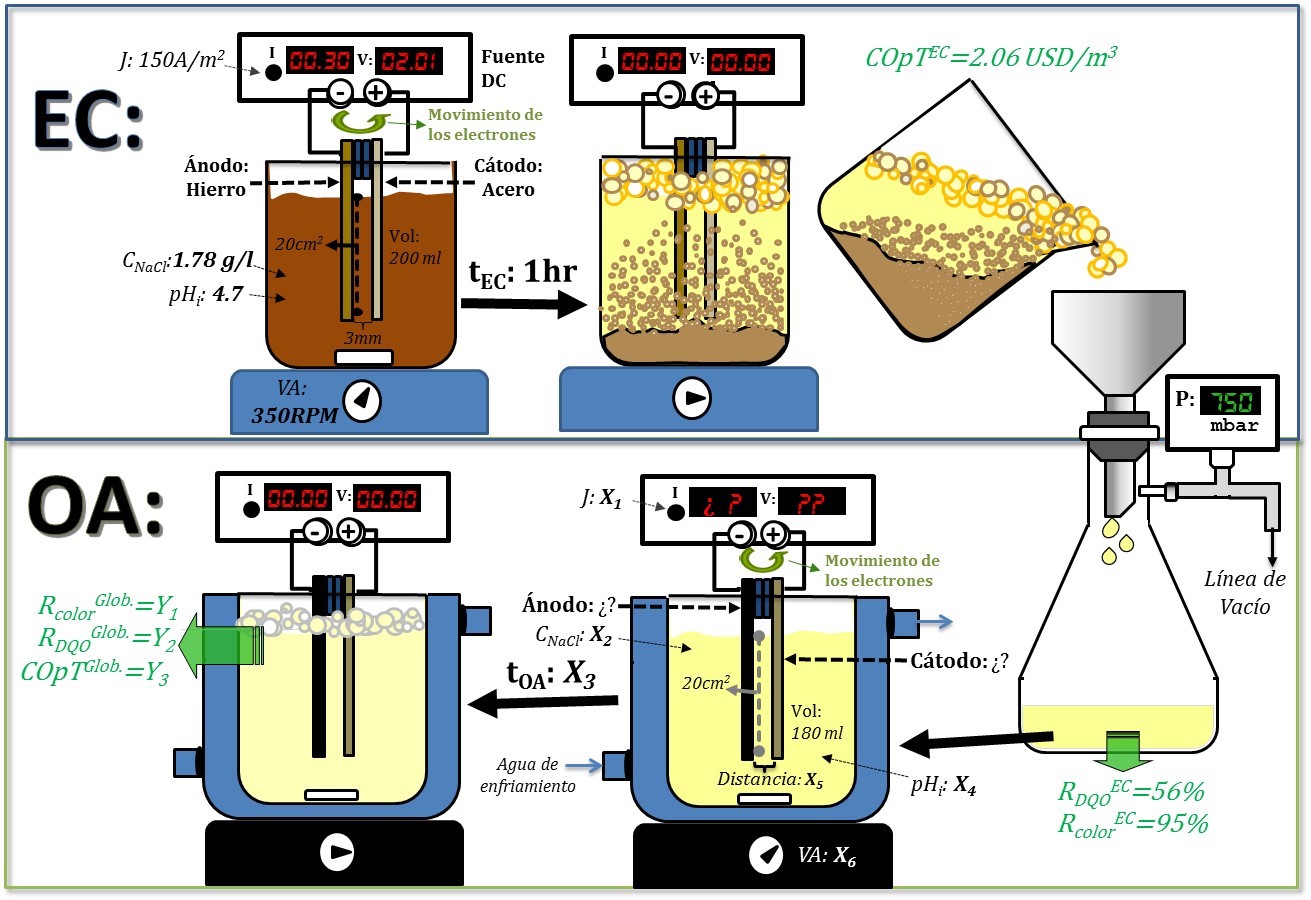The treatment of industrial wastewater originated from soluble coffee production via electrocoagulation - anodic oxidation. Electrodes selection
Tratamiento de aguas residuales de la industria del café soluble vía Electrocoagulación - Oxidación Anódica. Selección de los electrodos


This work is licensed under a Creative Commons Attribution-NonCommercial-NoDerivatives 4.0 International License.
Copyright statement
The authors exclusively assign to the Universidad EIA, with the power to assign to third parties, all the exploitation rights that derive from the works that are accepted for publication in the Revista EIA, as well as in any product derived from it and, in in particular, those of reproduction, distribution, public communication (including interactive making available) and transformation (including adaptation, modification and, where appropriate, translation), for all types of exploitation (by way of example and not limitation : in paper, electronic, online, computer or audiovisual format, as well as in any other format, even for promotional or advertising purposes and / or for the production of derivative products), for a worldwide territorial scope and for the entire duration of the rights provided for in the current published text of the Intellectual Property Law. This assignment will be made by the authors without the right to any type of remuneration or compensation.
Consequently, the author may not publish or disseminate the works that are selected for publication in the Revista EIA, neither totally nor partially, nor authorize their publication to third parties, without the prior express authorization, requested and granted in writing, from the Univeridad EIA.
Show authors biography
The industry of soluble coffee generates wastewater containing complex and hard to degrade mixtures of different substances. Their mineralization is not completely effective through conventional treatment methods. In this work, as a treatment alternative, a sequential Electrocoagulation-Anodic Oxidation (EC-AO) process is studied. The effect of electrode material (v.g., two different anodes (graphite and Boron-Doped Diamond (BDD)) and six different cathodes (stainless steel, titanium, iron, aluminum, graphite and BDD)) and of support electrolyte (NaCl or Na2SO4) on degradation performance of AO, in the terms of color and chemical oxygen demand (COD) reduction, as well as Total Suspended Solids (TSS) formation and pH, were experimentally tested. The obtained results were compared with the most recent Colombian environmental regulation. Additionally, for each case, a comprehensive operational costs analysis was performed. All the above information allowed to select two electrode systems as the most promising for the AO step: BDD-stainless steel + Na2SO4: very efficient but expensive (reduction of COD = 75% and 12 USD/ m3) and graphite-stainless steel + NaCl: less efficient and more economic one (reduction of COD = 67% and 7 USD/m3).
Article visits 1411 | PDF visits 763
Downloads
- Aguas De Manizales S.A. E.S.P.; 2016. Estudio de factibilidad para la recuperación y mantenimiento de la calidad de la cuenca del rio Chinchiná, URL: http://cort.as/-Itaf (acceso: 29-05-19).
- APHA. 2005. Standard Methods for the Examination of Water and Wastewater. 21st ed. Washington: Centennial edition
- Cardenas, A., Zayas, T., Morales, U., Salgado, L., 2009. Electrochemical Oxidation of Wastewaters from the Instant Coffee Industry Using a Dimensionally Stable RuIrCoOx Anode. ECS Trans. 20, 291-299.
- Clarke, R.J., Macrae, R., 1985. Coffee: Chemistry, 1st Edition. Ed. Elsevier Applied Science, London pp 45-58.
- Couto, R.M., Fernandes, J., da Silva, M.D.R.G., Simoes, P.C., 2009. Supercritical fluid extraction of lipids from spent coffee grounds. J. Supercrit. Fluids 51, 159-166. https://doi.org/10.1002/elsc.200900074
- Departamento Administrativo Nacional de Estadística DANE; 2018. Variación mensual del IPC por grupos de bienes y servicios 2017-2018. URL: http://cort.as/-ItaI (acceso: 29-05-19).
- Dinsdale, R.M., Hawkes, F.R., Hawkes, D.L., 1996. The mesophilic and thermophilic anaerobic digestion of coffee waste containing coffee grounds. Water Res. 30, 371-377. https://doi.org/10.1016/0043-1354(95)00157-3
- Dinsdale, R.M., Hawkes, F.R., Hawkes, D.L., 1997. Comparison of mesophilic and thermophilic upflow anaerobic sludge blanket reactors treating instant coffee production wastewater. Water Res. 31, 163-169. http://dx.doi.org/10.1016/S0043-1354(96)00233-3.
- EPM; 2018. Tarifas y Costo de Energía Eléctrica - Mercado Regulado.
- URL: http://cort.as/-Ita- (acceso: 29-05-19).
- Farah, A., 2012. Coffee Constituents, en: Coffee: Emerging Health Effects and Disease Prevention. Wiley- Blackwell, Oxford, pp. 21-58. http://dx.doi.org/10.1002/9781119949893.ch2.
- Federación Nacional de Cafeteros de Colombia, 2019. Información estadística cafetera. URL: http://cort.as/-ItZc (accedido 29/05/19)
- Fernandez, N., Forster, C.F., 1993. A study of the operation of mesophilic and thermophilic anaerobic filters treating a synthetic coffee waste. Bioresour. Technol. 45, 223-227. http://dx.doi.org/10.1016/0960-8524(93)90115-R.
- Ibarra-Taquez, H.N., GilPavas, E., Blatchley, E.R., Gómez-García, M.Á., Dobrosz-Gómez, I., 2017. Integrated electrocoagulation-electrooxidation process for the treatment of soluble coffee effluent: Optimization of COD degradation and operation time analysis. J. Environ. Manage. 200, 530–538, http://dx.doi.org/10.1016/j.jenvman.2017.05.095
- Ibarra-Taquez, H.N., Gómez-García, M.Á., Dobrosz-Gómez, I., 2018. Optimización multiobjetivo del proceso fenton en el tratamiento de aguas residuales provenientes de la producción de café soluble. Información Tecnológica, 29 (5), 111 – 122, http://dx.doi.org/10.4067/S0718-07642018000500111
- Kondamudi, N., Mohapatra, S.K., Misra, M., 2008. Spent Coffee Grounds as a Versatile Source of Green Energy. J. Agric. Food Chem. 56, 11757-11760. https://doi.org/10.1021/jf802487s
- Marketwatch (2019). Instant Coffee Market 2019 Global Key Players Analysis, Sales, Supply, Demand and Forecast to 2025, URL: http://cort.as/-ItZD
- Panchangam, S.C., Janakiraman, K., 2015. Decolorization of aqueous coffee and tea infusions by chemical coagulation. Desalin. Water Treat. 53, 119-125. http://dx.doi.org/10.1080/19443994.2013.860401
- Radjenovic, J., Sedlak, D.L., 2015. Challenges and Opportunities for Electrochemical Processes as Next-Generation Technologies for the Treatment of Contaminated Water. Environ. Sci. Technol. 49, 11292-11302. http://dx.doi.org/10.1021/acs.est.5b02414.
- Tokumura, M., Ohta, A., Znad, H.T., Kawase, Y., 2006. UV light assisted decolorization of dark brown colored coffee effluent by photo-Fenton reaction. Water Res. 40, 3775-3784. http://dx.doi.org/10.1016/j.watres.2006.08.012
- Tokumura, M., Znad, H.T., Kawase, Y., 2008. Decolorization of dark brown colored coffee effluent by solar photo-Fenton reaction: effect of solar light dose on decolorization kinetics. Water Res. 42, 4665-4673. http://dx.doi.org/10.1016/j.watres.2008.08.007.
- United States Department of Agriculture. 2018. Soluble Coffee Exports.
- http://cort.as/-Itc- (accedido 29/05/19)
- Zayas Pérez, T., Geissler, G., Hernandez, F., 2007. Chemical oxygen demand reduction in coffee wastewater through chemical flocculation and advanced oxidation processes. J. Environ. Sci. (China) 19, 300-305.




